Flagellum
![]()
This article deals with the filamentous structures on the cell surface; for the ancient Egyptian insignia of the same name, see Flagellum (Egyptian mythology).
Flagella (Latin flagellum) or flagella are thread-like structures on the surface of individual cells that serve for locomotion. They are fundamentally different in structure and function in prokaryotes (organisms without a cell nucleus) and in eukaryotes (organisms with a cell nucleus):
- Prokaryotes possess coiled protein filaments outside the cell membrane, which do not actively deform, but are set in rotation by a motor at their end anchored in the cell and in this way - similar to a propeller - exert a push or pull.
- Eukaryotes, on the other hand, have filamentous protrusions of the cell enclosed by the cell membrane, inside which is a bundle of microtubules, and which cause movement by actively changing shape.
These two completely different organelle types are respectively referred to as both flagella and flagella, so these two terms are used as synonyms. However, in order to take the different structure and function of prokaryotic and eukaryotic flagella into account nomenclaturally, the following language regulation has been proposed by German-speaking authors:
"The flagella of eukaryotic cells have a very uniform structure. [...] The term 'flagella' is reserved for the quite differently organized locomotory organelles of prokaryotes."
In the present article, this clear assignment of the designations "flagellum" for prokaryotes and "flagellum" for eukaryotes is largely taken into account (difficulties arise, for example, with "flagellum", cf. below). It should be noted, however, that other current textbooks do not make this distinction.
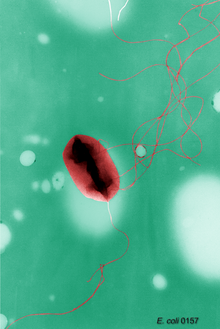
Cell of Escherichia coli with flagella; deformed by preparation; transmission electron microscopy
The flagella of prokaryotes
Structure
Bacterial flagella are extracellular, helical filaments ("filaments") that are anchored to the cell membrane(s) and cell wall via a "hook" with a motor complex. The flagella, including the hook and motor complex, are composed entirely of proteins. The diameter of the filaments in most flagella is about 15-20 nm, and they are hollow. Because of their small diameter, they can only be made visible by dark-field microscopy and electron microscopy, and not by normal light microscopy, but there are special staining procedures that thicken them enough to make them visible by light microscopy.
During the assembly of filaments, the protein molecules (flagellin) are transported through the hollow channel of the flagella to the outer end where they are attached. If there is a sufficiently large supply of flagellin in the cell, the assembly of a filament can happen very quickly.
The flagella of archaea are functionally similar to those of bacteria, but consist of different proteins and a different motor complex that is driven by ATP.
Flagellation types
According to arrangement and number of flagella, different types of flagella are distinguished (in the order of descending swimming speed):
- holotrich: numerous flagella are evenly distributed over the entire cell surface and cover the entire body surface
- peritrichous: many flagella are scattered evenly over the cell surface.
- polytrich-bipolar: the flagella are in two opposite groups at the cell poles. (also called amphitrichous).
- polytrich-monopolar: the flagella are in a group at one of the cell poles (also called lophotrich).
- monotrich: The cell has only one flagellum.
- polar: The flagellum or flagella are located at one or both poles of the cell.
- lateral, lateral flagella: flagella are located laterally, not at the poles of the cell.
Lateral flagellation is often not associated with high swimming speeds, but it offers the advantage that the bacterium can more easily squeeze into obstacles such as highly viscous liquids or gaps between solids.
Method of movement
Due to their helix, the flagella act similar to a propeller. The motor complex converts a difference in concentration of protons between the two sides of the inner cell membrane into a rotary motion of the coiled filament sitting on a curved "hook" and thus follows a similar construction principle as ATP synthase. The flagellar mechanism represents the only truly rotating joint known in all of biology to date. The rotation frequency is around 40-50 Hz.
The direction of the flagellar rotation caused by the motor in combination with the winding direction of the flagellar coil determines whether a push or a pull is exerted on the bacterial body. The direction of the rotation caused by the motor can be reversed in a very short time, so that push and pull can change quickly.
As a rule, the direction of rotation of the flagella is such that they push. This means that they are at the posterior end in monopolar flagellated bacteria. The bacterial body thereby rotates (more slowly) in the opposite direction (conservation of angular momentum).
In bipolar flagellated bacteria, the flagella of the two ends rotate in opposite directions. Thus, the flagella of the posterior end have a pushing effect, the flagella of the anterior end are bent backwards and rotate around the anterior end of the bacterial body, thus increasing the thrust. If the direction of rotation of the flagella is reversed, the filaments fold over, the rear end of the bacterium becomes the front end and the front end becomes the rear end, the bacterium swims in the opposite direction.
The flagella of peritrichous flagellated bacteria rotate in the same direction and usually in such a way that they push. In doing so, they unite to form a backward coiled bundle, also known as a "flagellar pigtail", which pushes the bacterium forward. If the direction of rotation of the flagella of peritrichous flagellated bacteria is reversed, the individual flagella straighten radially away from the bacterial body and their pulling action on the bacterial body cancels out on average, causing the bacterium to tumble in random motion in one place.
Reversal of the direction of flagellar rotation and the associated change in the direction of movement plays an important role in taxa (see for example chemotaxis).
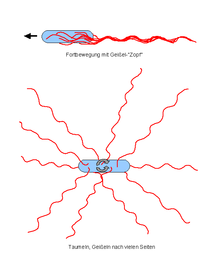
Arrangement of the flagella of peritrichous flagellated bacteria during locomotion and tumbling

Arrangement of the flagella of polar flagellated bacteria
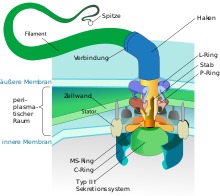
Motor complex of a flagellum of a gram-negative bacterium. The actual flagellum is in fact helical.
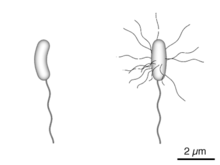
Vibrio cholerae with monotrichous flagella (left), Vibrio parahaemolyticus with one monotrichous and several peritrichous flagella (right).
The scourges of the eukaryotes
Structure
The flagella of eukaryotes are filamentous structures that project outward from the body into the surrounding medium and are surrounded by the cell membrane and filled with cytoplasm. Inside them lie microtubules in a special arrangement called 9×2+2; Nine double microtubules form a circle in cross-section, with two single microtubules in the middle. The double microtubules each consist of one complete microtubule (A-tubule) and one incomplete one (B-tubule). On the A-tubule, pairs of protein arms called dynein arms are located at equal height intervals, approximately every 20 nm. This microtubule arrangement is called the 9×2+2 structure, and the entire microtubule bundle is called the axoneme. This structure is stabilized by various bridging proteins (mainly nexin). At the base of the flagellum, where it merges into the cell body, there is a basal apparatus called the blepharoplast or kinetosome, which structurally resembles a centriol. It consists of nine triple microtubules in a circle (9×3 structure) that is transverse to a second 9×3 structure of the same structure. It is often referred to as a centriol. At the free end, the eukaryote flagella are pointed. Their diameter is about 250-300 nm, their length a few micrometers to more than 150 µm.
An illustrative example of flagellum-bearing cells is provided by spermatozoa. The movement goes in a wave with constant amplitude from the base to the tip of the flagellum.
Together with the cilia, the flagella of eukaryotes are also called undulipodia.
Method of movement
According to the current state of knowledge, the shape change required for hydrodynamic effectiveness is achieved by sliding of the double fibrils in opposite directions. The energy for this is to be provided by the dynein arms, namely by hydrolytic cleavage of phosphate from ATP. The protein dynein, which forms the dynein arms, has ATPase activity. Microtubule sliding results in a change in the shape of the flagellum.
The shape changes of the flagella vary depending on the type of flagella. They may consist in a wave (undulation) running over the flagellum in a plane or in the form of a helix with circular to elliptical movements; they may also consist in a flagellar stroke, whereby the flagellum curves in one direction and, as it were, infiltrates the medium and strikes outstretched in the opposite direction, thus exerting a force. Flagella which move in the manner last described are called cilia. They are usually shorter than other flagella, and are arranged in greater density on the surface of cells and tissues.
The consequence of the flagellar movement can be a locomotion of the individual, but it can also result in a movement of the adjacent medium or nearby particles when the individual is at rest. Examples of locomotion of the individual: freely moving ciliates, flagellates, spermatozoa. Examples of locomotion of the adjacent medium or particles: sessile ciliates, ciliated epithelium in the trachea of animals.
Variations, flagellation types
In some unicellular algae and protozoa, the flagella are occupied by many lateral short filaments called mastigonemes or cilia and are called ciliated flagella. The mastigonemes may occur in one row (stichonematic) or in two rows (pantonematic).
If a cell carries several flagella, it is called an isocont flagellum if they are of the same kind, as for example in green algae Cells with different flagella are called heterocont or anisocont, where usually a long, forward directed ciliated flagellum serves as a traction flagellum and a short smooth trailing flagellum is directed backwards, as for example in the heterocontae. Cells without flagella are called acont in distinction to the flagellated forms.
According to the place of insertion of the flagellum, a distinction is made between acrokont (at the front end, traction flagellum), pleurokont (lateral) and opisthokont (at the rear end, thrust flagellum).
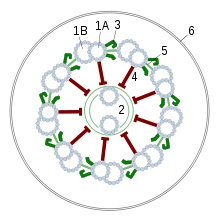
Schematic of a cross-section through a eukaryote flagellum, 1A + 1B - double microtubules at the periphery, 2 - two single microtubules in the middle, 3 - dynein arms, 4 - spokes, 5 - nexin junctions, 6 - cell membrane.
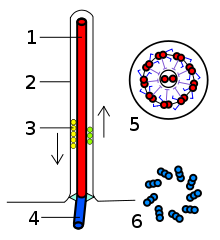
Schematic of a eukaryote flagellum, 1 - axoneme, 2 - cell membrane, 3 - mass transport within the flagellum, 4 - basal apparatus, 5 - cross-section through the flagellum outside the cell, 6 - cross-section through the basal apparatus inside the cell.
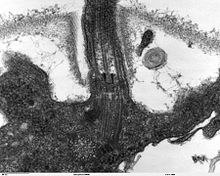
Longitudinal section through the base of a flagellum of Chlamydomonas rheinhardtii, transmission electron microscopy
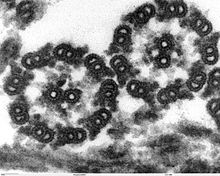
Transverse section through axonemes of flagella of Chlamydomonas rheinhardtii (Chlorophyta), transmission electron microscopy
Questions and Answers
Q: What is a flagellum?
A: A flagellum is a long, whip-like structure that helps some single celled organisms move.
Q: What is the composition of a flagellum?
A: A flagellum is composed of microtubules.
Q: How does a flagellum help propel cells and organisms?
A: A flagellum helps propel cells and organisms in a whip-like motion.
Q: What is the motion of the flagellum of eukaryotes?
A: The flagellum of eukaryotes usually moves with an “S” motion and is surrounded by cell membrane.
Q: What are cilia?
A: Cilia are cell organelles that are structurally almost identical with flagella.
Q: What is Protista?
A: Protista is a collection of disparate single-celled forms and a useful term for now.
Q: What is the origin of cell organelles such as cilia and mitochondria in eukaryotes?
A: All or most of these organelles have their origin in once-independent prokaryotes (bacteria or archaea), and the eukaryote cell is a 'community of micro-organisms' working together in 'a marriage of convenience'.
Search within the encyclopedia